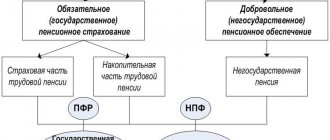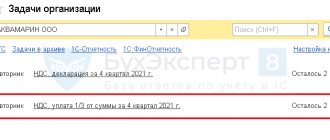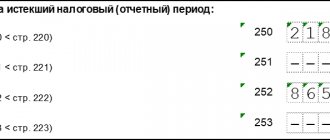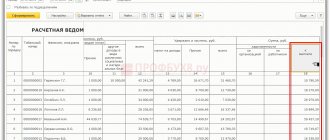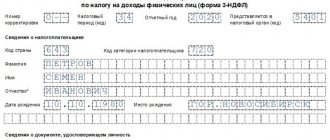4-FSS is a mandatory quarterly report for all legal entities and individual entrepreneurs who charge injury contributions for their employees under an employment or civil contract.
In 2022, it is necessary to submit the 4-FSS report four times: in January - for 2022, in April - for the first quarter of 2022, in July - for half a year, and in October - for 9 months of 2022. The report for the entire year 2022 is due in January 2023.
All insurers - organizations, as well as individual entrepreneurs with employees - submit a 4-FSS report on them. It is also rented out by individuals who hire official assistants under an employment contract, for example, a personal chef or driver.
We'll tell you what the 4-FSS report is, how to fill it out, in what ways and when to submit it.
Who, when and where to take 4-FSS in 2022
The report must be sent to the territorial office of the FSS:
- at the location of the organization (including if there are separate divisions without their own current account or that do not pay salaries to employees);
- at the place of registration of the unit , if it is allocated to a separate balance sheet, has employees and pays them independently;
- at the place of residence of the individual entrepreneur.
The 4-FSS report is submitted 4 times a year : at the end of the first quarter, half-year, nine-month period and year. The deadline for submitting the form depends on the form in which it is submitted. It, in turn, depends on the number of insured persons:
- if there are up to 25 people inclusive, then you can submit 4-FSS on paper or electronically, at the employer’s choice
- if 26 or more - only in electronic form
The deadline for submitting a report in paper form is the 20th day of the month following the reporting quarter, in electronic form - the 25th day .
That is, the tax office unobtrusively, in the form of longer deadlines, offers to submit it electronically.
The deadlines for submitting the report for the periods of 2022 are presented in the table:
| Period | On paper | In electronic form |
| I quarter | April 20, 2022 | April 25, 2022 |
| Half year | July 20, 2022 | July 25, 2022 |
| 9 months | October 20, 2022 | October 25, 2022 |
| In a year | January 20, 2023 | January 25, 2023 |
If an organization is undergoing liquidation, then the 4-FSS calculation must be submitted to the FSS before submitting an application for liquidation to the tax office. It must include data from the beginning of the year until the day the report is submitted to the fund. The amount of contributions must be transferred to the Social Insurance Fund within 15 days after submitting the report.
Changes to 4-FSS in 2022
The FSS developed a new form 4-FSS, which it planned to put into effect in the first quarter of 2022. The update is due to the fact that from January 1, 2022, the entire country switched to direct payments - the Social Insurance Fund pays sick leave and benefits directly to employees, rather than reimbursing the employer.
only the draft of the new 4-FSS form is available - the form should be significantly reduced. Information on the costs of insurance coverage, tables 2 and 3, will be removed from it. Table 1.1 will be added to decipher information about the base subject to contributions and the amount of calculated contributions for organizations with OP on a separate contribution rate. There are other changes too.
Anyone who reports using the old form and has switched to the direct payments project from the beginning of 2022 should take into account: do not fill out line 15 in table 2 and do not fill out and submit table 3.
The changes are aimed at simplifying the form. It was planned that the new form 4 - FSS will be applied starting from the first quarter of 2021. However, there is still no order to approve the new form 4-FSS.
Therefore, reporting on Form 4 of the Social Insurance Fund for the 4th quarter of 2022 must be submitted on the same form.
Organizations with more than 25 employees are required to submit Form 4-FSS via the Internet; Extern is suitable for this.
Who should take it?
The following categories are required to submit a report on Form 4 to the Social Insurance Fund:
- Companies, organizations and enterprises, regardless of the scope of their professional activities, registered on the territory of the Russian Federation.
- Individual entrepreneurs who have at least one employee.
Important ! If an individual entrepreneur works independently without hiring hired forces, then he has the right not to send information. Important ! If an individual entrepreneur works independently without hiring hired forces, then he has the right not to send information.
Before submitting the document, employers must comply with a number of conditions. They need to pre-pay to the fund 2.9% of the amount of wages received by a temporarily disabled employee or a woman on maternity leave. Amounts are calculated separately in case of injury at work. Their size is determined by the Foundation itself. Each case is considered individually. The amount of deduction can range from 0.2 to 8% of salary.
Form 4-FSS and its completion
The current form of the document was approved by order of the Social Insurance Fund dated September 26, 2016 No. 381 . The latest changes to it were made by order of the FSS dated 06/07/2017 No. 275 .
Only small companies can submit paper reports. It must be filled out using a pen with blue ink, using block letters. Errors can be corrected by carefully crossing out the incorrect indicator with the signature of the policyholder and the date of correction. You cannot use a corrector.
After filling out 4-FSS, you need to number the completed pages and have the report endorsed by the head of the company or his authorized representative. Each sheet of the report is endorsed.
the electronic report is numbered automatically and signed with an electronic signature.
The form consists of a title and 6 tables.
The title page, Table 1, 2 and 5 are filled out by all policyholders.
The remaining tables are filled in if necessary:
- table 1.1 - if the policyholder sent employees to temporary work in other organizations
- Table 3 - if you have sick leave for an injury at work
- table 4 - in case of accidents
Next, we'll look at how to fill out the form correctly.
Title page
The following information is indicated at the top of the title page:
- Policyholder registration number . This is the number that the company (IP) received when registering with the Social Insurance Fund.
- Subordination code . Code of the fund branch to which the policyholder is attached.
- Correction number . The original form states "000". If a clarifying calculation is submitted, “001”, “002” and so on are indicated.
- K period . Select a code from the options presented below the cell. For example, the first quarter corresponds to the code “03”, for the six months - the code “06”, for 9 months - “09”, for the year - the code “12”. The number of requests to the fund for compensation payments is indicated through a fraction.
- Calendar year . The year to which the reporting period relates is indicated - “2021”.
- Termination of activities. If the entity ceased to operate during the reporting period, “L” is indicated.
- Name. You must indicate the full name of the legal entity along with the legal form or the last name, first name and patronymic of the entrepreneur.
- Basic codes:
- TIN - 10 lines for an organization, 12 for an entrepreneur;
- Checkpoint - entrepreneurs do not indicate;
- OGRN (OGRNIP) - registration number of the company or individual entrepreneur from the Certificate of Registration;
- OKVED code is a code for the type of activity in accordance with the All-Russian Classifier.
- Contact phone number . Indicated along with the city code (format shown in the image below).
- Budgetary organizations . This field appeared in 2017 and is intended for budget organizations. The policyholder's attribute is entered in the field: 1 - Federal budget 2 - Budget of a constituent entity of the Russian Federation 3 - Municipal budget 4 - Mixed financing.
- Insured's address. Specified as shown in the image below:
Title page (beginning) - Information about the number:
- the average number of employees is indicated by all policyholders;
- the number of working disabled people and the number of workers engaged in work with harmful hazardous conditions is filled in if there are such workers.
- Number of sheets on which the calculation is presented. If there are attachments and supporting documents, this number of sheets is also indicated.
The lower part of the title page is intended for the signatory to confirm the completeness and accuracy of the information specified in the calculation. The rules for filling out this part are as follows:
- First of all, the status code of the signatory - the policyholder, his representative or legal successor.
- The following fields are filled in depending on who signs the calculation:
- Full name of the director of the policyholder;
- Full name of the individual entrepreneur;
- Full name of the policyholder's representative - an individual;
- name of representatives - legal entity.
- If a representative signs, the details of the document by which he is authorized to do so .
Title page (end)
Table 1. Calculation of the base for calculating insurance premiums
The table contains information on the amounts of payments and other remuneration accrued to individuals for each month of the reporting quarter and on the total amount of accruals for the year.
Table 1 consists of 9 rows. Lines 1-4 are filled in for each of the last three months of the reporting period. In columns 4 and 5 and 6, the indicator from column 1 is indicated monthly , and in column 3 - for the entire reporting period . These lines reflect the following data;
- line 1 - amounts of accrued payments to individuals;
- line 2 - amounts not subject to contributions;
- line 3 - taxable base - the difference between lines 1 and 2 for each column;
- line 4 - amounts of payments to disabled people included in the indicators of line 3.
The remaining lines reflect the following data:
- line 5 - insurance rate;
- line 6 - percentage of discount on the tariff, if it is established by the FSS department;
- line 7 - percentage of surcharge on the tariff, if it is established by the FSS department;
- line 8 - date of establishment of the premium from line 7;
- line 9 - the final tariff amount taking into account lines 6 and 7.
Base calculations based on the 4-FSS report
Table 1.1. Temporary transfer of its employees to other companies
This table is filled out if the policyholder has sent its employees temporarily to other companies . The lines are filled in for each organization or entrepreneur to which employees are sent. Accordingly, the data of the receiving party is reflected in the columns of the table. The following table shows how to fill out the fields.
| Column number | What to contribute |
| 2 | Registration number in the FSS |
| 3 | TIN |
| 4 | OKVED |
| 5 | Number of workers sent |
| 6 | Contributory payments to these employees for the reporting period |
| 7 | Contributory payments to disabled employees from those assigned |
| 8, 10, 12 | Payments to assigned employees for each of the last 3 months of the reporting period |
| 9, 11, 13 | Payments to disabled people from those referred for each of the last 3 months of the reporting period |
| 14 | Tariff size* |
| 15 | Tariff amount up to hundredths of a percent, taking into account discounts/surcharges* |
*Note . For employees sent for temporary work in other companies, contributions are calculated at the rate of the receiving party.
Table 2. Calculations for compulsory social insurance against industrial injuries and occupational diseases
The table contains calculations for contributions for injuries. The source of data for filling it out are accounting registers.
The table is visually divided into 2 parts. The left side is filled in as follows:
- Line 1 - the amount of the policyholder's debt to the Social Insurance Fund at the beginning of the period.
- Line 1.1 - the amount of debt of the legal successor transferred from the reorganized entity or the amount of debt of the insured remaining after the closure of a separate division.
- Line 2 - the amount of contributions accrued for the period. In addition to the total amount, it is indicated (in column 1): the amount at the beginning of the period;
- amounts for each of the last three months.
- Line 10 - due to excess costs;
The rows on the right side of the table are filled in like this:
- Line 12 — the amount of debt to the Social Insurance Fund at the beginning of the period, including:
- line 13 - due to excess costs;
- line 14 - due to overpayment.
- Line 14.1 - the amount of debt of the Social Insurance Fund to the insured-successor or the parent organization for a closed separate division.
- Line 15 - the total amount of social insurance expenses (column 3), including at the beginning of the period and for each of the last three months (column 1)
- Line 16 - amounts of paid contributions:
- at the beginning of the period;
- for each of the last three months (column 1 indicates the details of the payment order).
- Line 17 - amounts of debt written off, if applicable.
- Line 18 is the sum of lines 12, 14.1 - 17.
- Line 19 - the amount of debt owed by the policyholder at the end of the month.
- Line 20 - the amount of arrears as part of the amount from line 19.
Calculation and payment of insurance premiums in 4-FSS
Table 3. Expenses for payment of benefits for compulsory insurance against accidents and occupational diseases, financing of measures to prevent injuries
This table shows the costs of injury contributions . On lines 1-8, fill in columns 3 (number of days) and 4 (amount). Payment information must be provided:
- on line 1 - in connection with accidents
- on line 4 - in connection with occupational diseases
- on line 7 - for vacation for sanatorium treatment
Data on these payments is detailed. The number of days and amount are indicated in relation to persons who:
- suffered while working outside part-time (lines 2 and 5)
- suffered while working for another organization (lines 3, 6 and
For the rest of the line, the following information is indicated:
- line 9 - amount spent on measures to prevent injuries and occupational diseases;
- line 10 - total cost (sum of lines 1, 4, 7 and 9);
- line 11 - the amount of benefits that were accrued but not paid.
Table 4. Data on the number of insured employees who suffered due to an insured event at work
Information about the number of affected persons is reflected here . There are only 5 lines in the table, which indicates:
- in line 1 - the number of persons injured due to accidents, based on reports of industrial accidents in form N-1;
- in line 2 - the number of people injured in fatal accidents (included in the indicator from line 1);
- in line 3 - the number of persons affected by occupational diseases, based on acts on cases of occupational diseases;
- in line 4 - the total number of victims (line 1 + line 3);
- in line 5 - the number of persons who lost their ability to work only temporarily, based on data from sick leave.
Lines 1-3 indicate insured events for the reporting period according to the date of the examination .
Table 5. Information on the results of the special assessment of working conditions and preliminary and mandatory medical examinations of workers
This table reflects information about the results of a special labor assessment and medical examinations performed :
- Column 3 lines 1 . The total number of jobs subject to special assessment of working conditions is reflected. It does not matter whether such a center was carried out during the reporting period or not.
- Column 4 lines 1 . Data on the number of places where working conditions were assessed, including the third and fourth hazard classes ( columns 5 and 6 ).
- Column 7 line 2 . The number of workers in hazardous and hazardous industries who must undergo a medical examination.
- Column 8, line 2. The number of employees from the previous paragraph who underwent a medical examination in the previous year.
Information on the special assessment of working conditions
According to the rules, all data in the table must be at the beginning of the year, that is, as of January 1, 2022.
Filling
You can fill out Form 4 FSS online or on paper. The method depends on how the document will be submitted. The most important thing when filling out is not to make mistakes, fill it out carefully. Any inaccuracy will lead to problems that will be difficult to correct. Versions of accounting programs make it possible to fill out 4 FSS online, and an example of filling.
Sample form
Step-by-step instructions for filling out the title page include the following points:
- The correction number is entered. It is not required if the report is submitted for the first time.
- A reporting period consisting of a code is entered. For the first quarter the numbers are 03, for the second - 06.
- Full name of the organization. It must be indicated exactly as in the constituent documents. All details are provided, including checkpoint, INN, OGRN.
- The payer code must be entered. The first three cells must be filled out in accordance with Appendix No. 1 to the Procedure for filling out the calculation.
- The average payroll column indicates the number of insured employees. This should also include all female employees who are currently on maternity leave, as well as parental leave for children up to one and a half years old.
Next comes filling out the sections. The first of them contains information about all sick leave and payments due to temporary disability for the quarter:
- Paragraph No. 1 specifies the amount of the organization’s debt to the Social Insurance Fund, as well as the Fund’s debt to the company itself.
- The second column reflects the amount of contributions for the reporting quarter and for the past. In the report for the first three months of the year, the figure will contain only the amount for three months. In the future, throughout the year, each new quarter it will grow.
The second section reflects information about injuries sustained at work, as well as occupational diseases. In this paragraph, the accountant writes down the amounts of contributions for individuals, information about the use of a reduced tariff for calculating insurance premiums. This should also include amounts that are not subject to tax.
If errors were made during the reporting process, the form must be filled out again. It is submitted to the Social Insurance Fund indicating that this is an adjustment. The correction number must be entered.
Important ! It is mandatory to send corrected data as soon as erroneous information is discovered. Even if an inaccuracy is discovered after a year, you still need to submit a clarification form.
Corrections must be sent even if the error was in favor of the company. In such a situation, filing a new report becomes the direct responsibility of the accountant.
A clarifying version of the latest report is submitted in the following cases:
- Errors were made when making calculations, which lead to changes in the sum insured and to leaving it unchanged.
- If the report does not reflect at all or incompletely reflects mandatory information.
- When transmitting false information.
Important! The correct report must be made in the same form in which it was originally submitted.
A comment must be indicated indicating the type of adjustment. The number 1 is placed if the clarification concerns the amount of payment of contributions. Value 2 is applicable if it is necessary to clarify the amounts of pension insurance that have been accrued. Number 3 is intended to indicate changes in the amounts of health insurance premiums.
As a separate item, it is necessary to consider the 4th FSS zero report, a sample of which can be filled out on the official website. It must be submitted within the same time frame as the main one. The document confirms that there were no accruals for the past quarter. The zero format is taken by all legal entities, regardless of the number of their employees.
The composition of the zero report includes:
- title page;
- 1,2 and 5 tables.
You can send the form through the FSS portal for reporting. In the case of a zero calculation, an explanatory note is attached, which indicates that the entrepreneur did not work in the specified quarter, did not pay wages, and therefore no contributions were received from him.
Zero form 4-FSS in 2022
An organization or entrepreneur that did not work during the reporting period and did not make any contributions to employees must also report in Form 4-FSS. In this case, you must submit the zero form and thereby inform the Social Insurance Fund about the lack of activity in the reporting period.
As part of the zero form, a title page and tables 1, 2 and 5 are submitted, which are filled in with dashes. Along with the form, you can submit to the Social Insurance Fund an explanation that you did not work, did not pay salaries, and, therefore, did not make contributions to the fund. But this is not necessary; if necessary, the FSS itself will request the necessary information.
How to check whether benefit 60 is indicated correctly in 4-FSS?
To better understand the explanations about the correctness of indicating benefit 60 in 4-FSS, let’s move on to consider a simple example.
Example
The accountant forms 4-FSS for two companies:
- public organization of disabled people “Legal Aid” - belongs to category 2 insurers;
- LLC "Lawyer Profi" belongs to category 1 insurers, since the organization has disabled employees on its staff.
The rate for contributions for injuries in both organizations is set at 0.2%. There are no discounts or surcharges on the tariff.
Based on the results of the 1st quarter of 2016, organizations made the following payments to employees:
| Period | Amount of payments, rub. | ||
| NGO "Legal Aid" | LLC "Lawyer Profi" | ||
| Total | including disabled workers | ||
| January | 82 460,00 | 123 940,00 | 61 320,00 |
| February | 83 120,00 | 135 370,00 | 67 830,00 |
| March | 81 970,00 | 115 890,00 | 55 740,00 |
| Total for the 1st quarter 2016 | 247 550,00 | 375 200,00 | 184 890,00 |
When filling out and checking 4-FSS for the OIO “Legal Aid” in the accounting program, you need to ensure that the following conditions are met:
When filling out and checking 4-FSS for Lawyer Profi LLC, the accounting program monitors compliance with the following conditions:
For detailed explanations on how to correctly fill out tables 6 and 7 of the 4-FSS report, read the thematic articles:
- “Filling out Table 6 of Form 4-FSS - rules and sample”;
- “How to fill out table 7 of the 4-FSS report - rules and sample.”
Fines
Late delivery
Late filing of 4-FSS will result in a fine under Article 19 of Law 125-FZ . Its size is 5% of the amount of contributions that are payable to the budget for the last 3 months of the reporting period. The fine increases by 5% for each full and partial month of delay. The fine limits are:
- minimum - 1000 rubles
- maximum - 30% of the amount of contributions
There is also administrative liability for officials - 300-500 rubles .
Paper report instead of electronic
For submitting a paper report instead of an electronic one, a fine of 200 rubles . Additionally, a warning or fine for officials is possible - 300-500 rubles .
Regulatory acts
- Order of the Federal Insurance Service of the Russian Federation dated September 26, 2016 N 381 (as amended on June 7, 2017) “On approval of the form of calculation for accrued and paid insurance contributions for compulsory social insurance against industrial accidents and occupational diseases, as well as for expenses for the payment of insurance coverage and The order in which it should be filled out."
- Resolution of the Ministry of Labor of Russia dated October 24, 2002 N 73 (as amended on November 14, 2016) “On approval of the forms of documents required for the investigation and recording of industrial accidents, and provisions on the features of the investigation of industrial accidents in certain industries and organizations.”

